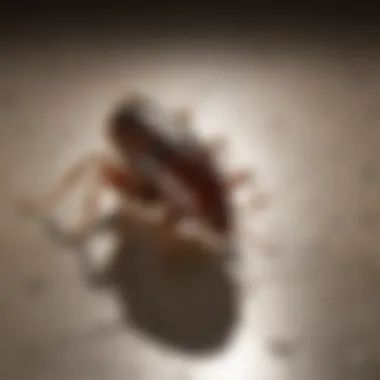Best Cockroach Traps: A Comprehensive Guide


Intro
Cockroaches are more than just unwanted visitors in our homes; they are pests that pose significant health risks. Understanding these creatures is essential for effective control. This guide provides an analysis of the best cockroach traps available, focusing on various types and their effectiveness while addressing safety and environmental considerations. Homeowners, pest control professionals, and eco-conscious individuals will find valuable insights and practical techniques for managing infestations.
Understanding the Pest
Identification
Before choosing a trap, it is vital to identify the type of cockroach you are dealing with. Common varieties include the American cockroach, German cockroach, and Oriental cockroach. Each species has distinct characteristics. For instance, the German cockroach is smaller and typically found in kitchens and bathrooms, whereas the American cockroach is larger and tends to inhabit basements or drains.
Life Cycle
Understanding the life cycle of cockroaches can aid in selecting the right control strategies. Cockroaches undergo three stages: egg, nymph, and adult. The egg stage can produce up to 40 nymphs, which grow into adults in about three months. Knowing this cycle is crucial because it informs timing for trap placement and maintenance.
Pest Prevention Strategies
Environment Modification
Preventing cockroaches starts by modifying the environment. Keeping areas clean and eliminating food sources is essential. Regularly cleaning crumbs and spills can deter these pests. Moreover, sealing cracks and crevices in walls can block their entry points.
Physical Barriers
Another effective strategy is employing physical barriers. Utilizing screen doors and mesh filters in ventilation openings can help keep cockroaches out of your home. This proactive measure is often overlooked but can significantly reduce the likelihood of infestations.
Control Methods
Chemical Control
Chemical control can be effective but must be used cautiously. Many commercial traps contain insecticides designed to attract and kill cockroaches. While these can be effective, it is essential to follow safety instructions closely to minimize health risks to humans and pets.
Biological Control
Biological methods are also gaining traction as eco-friendly alternatives. These methods involve using natural predators or pathogens that specifically target cockroaches. Such methods have the potential to manage populations with minimal environmental impact.
"Understanding these pests and controlling them effectively requires knowledge about their behavior and life cycle."
Understanding Cockroach Behavior
Understanding the behavior of cockroaches is crucial for effective pest control strategies. Knowledge about their habits, habitats, and feeding tendencies not only helps homeowners identify potential infestations but also enhances the efficiency of traps. Cockroaches are resilient creatures, and their behaviors can influence how and where traps should be placed. Analyzing their patterns provides insights into the most effective ways to eliminate them.
Cockroach Species Overview
Cockroaches belong to the order Blattodea, with over 4,600 species identified globally. However, only a few species manage to invade homes and buildings. The most common species found in domestic settings include the American cockroach, German cockroach, and Oriental cockroach.
- American Cockroach: This species is large, reaching up to 3.5 inches in length. It is reddish-brown with a yellow margin on its thorax. Habitat preference includes warm, humid environments.
- German Cockroach: Smaller in size, typically about 0.5 to 0.7 inches, the German cockroach is light brown and recognizable by the two dark stripes on its back. This species thrives in kitchens and places with easy access to food and water.
- Oriental Cockroach: Known for its dark brown to black coloration, this cockroach is about 1 to 1.3 inches in length. It prefers cooler areas like basements and sewers.
Understanding these species helps in choosing the right cockroach traps that can effectively target them.
Habitat and Activity Patterns
The habitats of cockroaches are closely tied to their survival. Cockroaches are nocturnal, typically active at night. During the day, they often hide in dark crevices, under appliances, and in moist areas, such as bathrooms and kitchens. Their preference for warmth and moisture directs homeowners to inspect these potential hiding spots when dealing with an infestation.
Key points to consider about their habitat include:
- Moisture: Cockroaches are drawn to damp environments. Any leaks or standing water can attract them.
- Food Sources: They can thrive on a variety of organic materials, including crumbs of food, pet food, and even paper.
- Shelter: Clutter around the home can provide ideal hiding places, making regular cleaning and organization important for prevention.
Feeding Habits of Cockroaches
Cockroaches have diverse feeding habits, often consuming whatever is available. Their diets mainly consist of:
- Starch-based substances: Bread, cereals, and pasta are particularly attractive to them.
- Sugars: Sweet items like candies can lure cockroaches into domestic environments.
- Grease: Oils and fats are equally enticing, making kitchen areas prime targets.


These feeding habits further emphasize the need for cleanliness. Keeping food stored properly and minimizing crumbs can significantly deter cockroach activity.
"The best prevention against cockroaches involves maintaining a clean environment and understanding their habits."
With this base knowledge about cockroach behavior, homeowners can follow effective pest control measures. It ensures that traps placed in strategic areas will have a higher chance of success, resulting in a more effective solution to cockroach problems.
Types of Cockroach Traps
Understanding the types of cockroach traps is crucial for effective pest management. Each trap type has its distinct mechanisms and advantages that cater to specific needs. Homeowners must consider factors like effectiveness, safety, and ease of use when selecting a trap. The right choice not only ensures efficient pest control but also minimizes safety concerns and environmental impact.
Glue Traps
Glue traps are among the most popular options for managing cockroach infestations. They operate on a simple principle: a sticky adhesive surface captures insects that walk across it. These traps are widely accessible and do not require special skills for setup.
Advantages of Glue Traps:
- Simplicity: Easy to use; no assembly required.
- Low Cost: Usually affordable, making them suitable for quick fixes.
- Discreet: They can be placed in hidden areas, reducing visibility.
The effectiveness of glue traps, however, can vary. These traps often catch fewer insects compared to bait stations or snap traps. It is also important to note that glue traps can pose risks to non-target animals if not placed with caution. Positioning them in areas where pets and children cannot access helps mitigate this risk.
"To ensure success with glue traps, it is vital to replace them regularly and check them frequently to manage the cockroach population effectively."
Snap Traps
Snap traps are known for their quick action. They use a mechanical mechanism that snaps shut upon contact with a cockroach. This instant kill technique is appealing for those who prefer a more direct approach to pest control.
Key Benefits of Snap Traps:
- High Efficiency: These traps can capture multiple cockroaches at once.
- Quick Results: They act rapidly, reducing the roach population effectively.
- Reusable: Snap traps can be cleaned and used multiple times, offering good value.
However, caution is necessary when using snap traps. Improper placement can lead to accidental captures of pets or children. Therefore, informing household members about the trap locations is a good practice to prevent accidents.
Electrocution Traps
Electrocution traps offer a modern solution for pest management. They use a high-voltage charge to kill cockroaches on contact. This method effectively targets larger infestations and minimizes the need for regular replacements.
Electrocution Traps Advantages:
- High Capacity: Can handle multiple cockroaches simultaneously.
- Clean Kill: No mess to clean up afterward.
- Indicator Lights: Many models include lights that indicate when a catch has occurred.
Despite their benefits, electrocution traps can be more expensive than other options. Homeowners should consider their specific situation and budget before choosing this type. Additionally, they must ensure proper placement to avoid risks of electrical hazards.
Bait Stations
Bait stations employ a different tactic by luring cockroaches with a poisoned attractant. Once consumed, the poison affects the cockroaches, leading to their demise over time. These traps are effective for ongoing pest management, especially in areas with significant infestations.
Benefits of Bait Stations:
- Long-Lasting: They provide long-term control as cockroaches consume the bait and share it with others, reducing the population.
- Safe for Home: Typically, bait stations are designed to prevent access by children and pets.
- Discreet: They can be placed out of sight while still being effective.
While bait stations require patience as the issues may not be resolved immediately, their long-term efficacy often makes them a preferred choice.
Criteria for Selecting the Best Trap
When it comes to dealing with cockroach infestations, the choice of trap affects not only the effectiveness of control efforts but also the overall peace of mind for homeowners. Understanding the key criteria for selecting the best trap is essential. It enables informed decisions based on specific needs. Here we explore four main considerations: effectiveness against different species, ease of use, safety considerations, and environmental impact.
Effectiveness Against Different Species
Different species of cockroaches respond to traps in various ways. Common types include the German cockroach, American cockroach, and oriental cockroach. Each species has unique behaviors and habitats that affect how they interact with traps.
- German cockroaches tend to prefer warm and humid environments, often residing in kitchens and bathrooms. Therefore, traps set near food sources may be particularly effective.
- American cockroaches, on the other hand, are larger and can thrive outdoors as well. Their traps may need to be placed both inside and outside the home to reduce their numbers effectively.


Choosing traps that specifically target the species in your area greatly enhances the chances of successful elimination. Consider traps that visually indicate effectiveness, such as those that allow you to see captured insects.
Ease of Use
A trap’s ease of use is critical for homeowners who may not have experience with pest control. Complicated traps can lead to improper use, resulting in reduced effectiveness and frustration. When selecting a trap:
- Look for straightforward installation methods. Ideally, traps should not require tools or special expertise to set up.
- Some traps are disposable, making them convenient for quick replacement after use. A trap that needs little maintenance or cleanup adds to its attractiveness.
Ultimately, the ease of use can dictate how consistently the trap is utilized, impacting results.
Safety Considerations
Safety should always be a primary concern when choosing traps, particularly if you have children or pets in the household. Not all traps are created equal in this regard. Some points to keep in mind:
- Non-toxic options: Glue traps and some bait stations use less harmful substances, reducing the risk of accidental poisoning.
- Placement safety: Ensure traps are strategically placed out of reach of young children or pets while still being effective.
Additionally, be informed about any potential risks associated with specific traps. Reading product labels carefully can greatly mitigate safety issues.
Environmental Impact
More consumers are concerned about the environmental effects of pest control products. Selecting eco-friendly options is becoming increasingly important. Some aspects to consider include:
- Biodegradable materials: Traps made from sustainable materials minimize waste.
- Chemical usage: Products that emphasize natural ingredients reduce harmful impacts on local ecosystems.
Incorporating eco-conscious criteria not only addresses environmental concerns but also aligns with values of many homeowners seeking effective, sustainable solutions for pest management.
Understanding these criteria can significantly impact the choice of trap you make, leading to successful management of cockroach problems in your home.
Top Cockroach Traps Reviewed
In this section, we will evaluate some of the leading cockroach traps available on the market. Understanding which traps are effective can help homeowners choose the right solution for their specific pest problem. The importance lies in recognizing that not all traps are equal; factors like species targeted, ease of use, and environmental considerations play a significant role in the overall effectiveness.
By examining these products, we aim to equip homeowners with necessary insights to make informed decisions regarding cockroach control.
Detailed Product Reviews
Best Glue Traps
Glue traps are especially valued for their simplicity and efficiency. They consist of sticky surfaces that capture cockroaches as they walk across them. One key characteristic of glue traps is their ready-to-use design, which makes them accessible for anyone. Homeowners often prefer them because they require no baiting or complicated setup.
The unique feature of glue traps is their extended surface area, allowing for capturing multiple roaches at once. This can be advantageous in larger infestations where rapid results are necessary. However, a disadvantage is that these traps do not immediately eliminate the pest, leading to prolonged suffering.
Best Snap Traps
Snap traps are another popular choice among homeowners. They work by using a spring-loaded mechanism that kills cockroaches instantly upon contact. A key characteristic of snap traps is their high effectiveness rate; they tend to produce quicker results when compared to glue traps. This immediate response is vital for those wanting prompt pest control.
A unique aspect of snap traps is the ability to reset after catching a cockroach. This allows for continuous use without needing constant replacement. However, setting the trap can be tricky for those unfamiliar, making it a bit less user-friendly, especially for first-time users.
Best Electrocution Traps
Electrocution traps offer a modern approach to cockroach control. They use electric currents to kill pests upon entry. This aspect makes them highly effective against various cockroach species. One key characteristic of these traps is their ability to kill multiple insects over time without needing constant monitoring. Many homeowners appreciate this hands-off approach.
The unique feature of electrocution traps is their built-in bait, which lures roaches into the trap. This ensures high catch rates. However, they require a power source, limiting where they can be used. Additionally, initial costs may be higher compared to simpler traps.
Best Bait Stations
Bait stations combine both bait and trapping in one device. They contain poison that attracts roaches and leads to their demise over a period of days. One significant characteristic of bait stations is their discretion. They can be placed discreetly, reducing the visibility of pest control measures for homeowners.
Their unique feature is how they allow for slow poisoning, which can reduce the likelihood of cockroaches dying in visible areas. However, a downside is that it may take longer to see results, as the roaches must consume the bait before dying. This method requires patience and can lead to concerns about pets and children if placed in accessible locations.
Installation and Maintenance


Proper installation and maintenance of cockroach traps play crucial roles in ensuring an effective pest control strategy. Understanding these two components can significantly enhance your success in combating cockroach infestations. With an effective installation, traps can capture the pests more efficiently, while regular maintenance ensures they continue to function as intended.
Proper Installation Techniques
- Identifying Strategic Locations: Position traps in areas where cockroaches are most active. Common places include near trash cans, under sinks, and behind appliances. This increases the likelihood of trapping these pests.
- Following Manufacturer Instructions: Each trap type has specific installation requirements. Adhering to these guidelines optimizes performance. For instance, glue traps should lie flat to ensure maximum contact with roaches.
- Adjusting to Environmental Conditions: Make sure traps are not placed in overly windy or damp areas, as environmental factors can hinder trap performance. Also, consider the temperature; some traps perform better at certain temperatures.
- Using Multiple Units: Spread out traps across various locations for a comprehensive approach. A single trap may not suffice, especially during a severe infestation.
Traps should be arranged in a grid-like pattern for optimal coverage, particularly in large spaces.
- Monitoring Trap Placement: Regularly evaluate the effectiveness of trap locations. If you find traps are not catching anything, reposition them. This adaptability is key to effective removal of cockroaches.
Maintenance of Traps
Maintenance is as important as installation. Here are tips for keeping traps effective:
- Regular Checks: Inspect traps frequently to determine their effectiveness. Look for captured cockroaches or residual bait and change traps when necessary.
- Cleaning: Remove any debris or dust around and on the traps to prevent obstacles that may deter cockroaches. A clean environment around the trap enhances its visibility to the target pests.
- Replacing Bait: For bait stations, replace the bait according to the manufacturer's recommendation. Expired or dry bait is less enticing to cockroaches.
- Disposal of Captured Pests: Dispose of captured cockroaches immediately to minimize potential odors and reduce the risk of other pests.
- Inspecting for Damage: Look for signs of wear and tear. If traps are damaged or expired, replace them. A malfunctioning trap will not perform at its best.
By understanding the importance of proper installation and maintenance, you can significantly improve the effectiveness of your cockroach traps. Keeping traps clean, functional, and strategically placed is vital in reducing and managing cockroach populations.
Common Myths About Cockroach Traps
Understanding the myths surrounding cockroach traps is vital for effective pest management. Misconceptions can lead to improper use of traps or misguided reliance on ineffective methods. By clarifying these myths, homeowners can improve their strategies for controlling infestations. Awareness of the realities can also enhance overall success in managing pests. This section aims to dismantle common myths and provide clearer insights into effective cockroach control.
Debunking Misconceptions
- Myth: All traps kill cockroaches the same way.
The reality is that traps function differently based on their design. Glue traps capture cockroaches without killing them immediately, while snap traps and electrocution traps aim for instant kill. Each type serves different scenarios and choosing the correct trap matters significantly. - Myth: You only need one trap for a whole house.
Many believe one trap can suffice for an entire home. This is misleading. Cockroaches tend to hide in multiple areas. Placing several traps strategically increases the chance of capturing these pests. - Myth: If I don’t see cockroaches, I don't have an infestation.
Cockroaches are nocturnal and can hide well. If you suspect an infestation, proactive measures are crucial. Traps can help monitor and detect activity even when you can't see the pests. - Myth: Natural traps are less effective.
Some people think that only chemical traps work effectively. While chemical traps can be potent, natural alternatives can also be successful depending on the situation. It often depends on the method and placement of the trap.
Understanding Trap Limitations
Every trap has its limitations, which are essential to acknowledge in pest management.
- Effectiveness varies by species. Not all traps catch every type of cockroach. Specific traps are designed for particular species, and using a trap unsuitable for the target can lead to poor results.
- Limited lifespan. Traps can lose their efficacy over time. For instance, glue traps can become less sticky or contaminated, reducing their ability to catch cockroaches. Regular replacement is necessary.
- Environmental factors play a role. The placement of traps can significantly impact their performance. Traps located in areas with heavy foot traffic may be less effective. Cockroaches may avoid traps in busy areas, making it important to find a balance in placement.
- Can't eliminate infestation alone. Relying solely on traps will not provide a long-term solution. Effective pest management requires a comprehensive approach, combining traps with other methods. For example, sealing entry points and maintaining cleanliness also play a key role in reducing cockroach populations.
A proper understanding of both myths and limitations is essential for homeowners seeking to improve their pest management strategies.
By debunking these misconceptions and recognizing traps' limitations, homeowners can take informed steps towards effective cockroach management, ultimately protecting their homes more efficiently.
Integrating Traps into Pest Management
The integration of traps into a pest management strategy is crucial for maintaining an effective control over cockroach populations. Traps alone may not eliminate an infestation, but they serve as valuable tools within a broader management plan. Understanding how to incorporate traps into your overall strategy can enhance effectiveness, reduce reliance on chemical treatments, and safeguard your living environment.
By effectively integrating traps, homeowners can monitor pest activity and take timely action. This proactive approach helps to identify infested areas and informs the choice of other control measures. Traps provide visual evidence of infestations and capture data on species present, which can guide appropriate treatment methodologies.
Complementing Other Control Measures
Utilizing traps alongside other control measures forms a holistic approach to pest management. Here are some methods that complement trap use:
- Sanitation Practices: Maintaining cleanliness reduces available food and shelter for cockroaches. Regular cleaning combined with traps can accelerate the removal of pests from the vicinity.
- Insecticides: Traps can supplement chemical methods. Using an insecticide targeted at captured roaches can maximize efficiency, leading to quicker results.
- Natural Deterrents: Employ natural repellents along with traps for a combined effect. Essential oils like peppermint and tea tree oil can deter cockroaches while traps catch those that may enter.
Integrating various strategies creates a comprehensive plan. For instance, setting traps in conjunction with sealing entry points can prevent future infestations.
Long-Term Pest Management Strategies
Long-term pest management encompasses more than immediate relief from roaches. Here are some strategies:
- Consistent Monitoring: Regularly check traps to track pest activity. This helps you gauge the severity of the infestation and the effectiveness of your methods.
- Continuous Education: Stay informed on cockroach behavior and control technologies. Learning about new products or techniques can empower you to use traps more effectively.
- Seasonal Adjustments: Understand that cockroach activity may change with the seasons. Adjusting trap placements during peak activity times can improve catch rates.
- Community Engagement: Work with neighbors or local pest control professionals. Sharing insights and strategies can lead to better results in managing local pest populations.
By integrating traps strategically into your pest management plan, you not only address current infestations but also reduce the risk of future issues.
Epilogue
In summary, understanding the best cockroach traps is crucial for maintaining a clean and healthy home environment. The concluding section of this article emphasizes the significance of selecting the right type of trap. Homeowners often face the challenge of not just eliminating the infestations but also preventing future occurrences. This is where traps become a central element of an effective pest management strategy.
Choosing the appropriate trap depends on various factors including effectiveness against specific cockroach species, ease of use, safety, and environmental considerations. By being informed about the strengths and weaknesses of different traps, readers can make decisions that align with their specific needs. For example, glue traps are less intrusive but may require frequent checking, while snap traps may provide faster results but can pose a hazard if not handled cautiously.
Furthermore, integrating these traps within a broader pest control approach enhances their effectiveness. Complementing traps with cleaning and sanitary measures ensures that the sources of attraction for cockroaches are minimized. By fostering a systematic approach to pest management, homeowners can create an unwelcoming environment for cockroaches.
Also, recognizing common myths surrounding cockroach traps can empower readers to adopt realistic expectations. It is important to understand that while traps are a valuable tool, they are not a standalone solution. This comprehensive guide equips homeowners not only with knowledge about specific traps but also with a strategic mindset toward long-term pest prevention. Thus, the overarching message here is clear: informed choices lead to successful outcomes against cockroach infestations.







